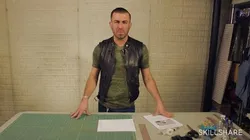
Grading Pattern Making Manual - Fashion 
This course provides an introduction to grading pattern making for fashion. It covers a brief theory on grading, as well as how to create a measurement chart and grade increments for the bodice, sleeve, and skirt. It also covers how to split a diagram and how to grade a pattern. Students will gain the skills to create a pattern grading manual. ▼
ADVERTISEMENT
Course Feature
![]() Cost:
Cost:
Free Trial
![]() Provider:
Provider:
Skillshare
![]() Certificate:
Certificate:
Paid Certification
![]() Language:
Language:
English
![]() Start Date:
Start Date:
On-Demand
Course Overview
❗The content presented here is sourced directly from Skillshare platform. For comprehensive course details, including enrollment information, simply click on the 'Go to class' link on our website.
Updated in [February 21st, 2023]
Unlock the Exciting World of Learning! Here's What Awaits You: This course will teach learners the tricks of the trade in pattern making and grading. Learners will gain an understanding of grading increments and how to create a measurement chart. They will learn how to split diagrams for a bodice, sleeve, and trouser, as well as how to mark up track lines and grade up and down one size. Learners will also gain insight into solving tricky problem areas and variations on specific grading areas. This course is suitable for fashion students, fashion lovers, industry professionals, hobbyists, pattern cutters and makers, aspiring home dressmakers, and fashion enthusiasts. The equipment needed is basic bodice block/sloper, pencil, ruler, rubber, calculator, measuring tape, pattern paper, notcher, tracing wheel, blocks or patterns to grade, and a creative and mathematical head.
[Applications]
Participants will be able to apply the knowledge and skills acquired to create their own grading patterns for fashion garments. They will be able to create measurement charts and grade increments, split diagrams for bodice, sleeve and trouser, mark up track lines, and grade up and down one size for a bodice, trouser and sleeve. Participants will also be able to solve tricky problem areas and variations on specific grading areas.
[Career Paths]
Answer:
1) Pattern Cutter: Pattern cutters are responsible for creating patterns for garments based on the design specifications. They use a variety of tools and techniques to create patterns that are accurate and precise. Pattern cutters must have a good understanding of garment construction, fabrics, and design principles. They must also be able to work with a variety of materials and be able to adjust patterns to fit different sizes. The demand for pattern cutters is increasing as the fashion industry continues to grow.
2) Technical Designer: Technical designers are responsible for ensuring that garments are produced to the highest quality standards. They work closely with pattern cutters, garment makers, and other professionals to ensure that garments are produced according to the design specifications. Technical designers must have a good understanding of garment construction, fabrics, and design principles. They must also be able to work with a variety of materials and be able to adjust patterns to fit different sizes. The demand for technical designers is increasing as the fashion industry continues to grow.
3) Grader: Graders are responsible for grading patterns to create different sizes of garments. They use a variety of tools and techniques to grade patterns accurately and precisely. Graders must have a good understanding of garment construction, fabrics, and design principles. They must also be able to work with a variety of materials and be able to adjust patterns to fit different sizes. The demand for graders is increasing as the fashion industry continues to grow.
4) Quality Control Inspector: Quality control inspectors are responsible for ensuring that garments are produced to the highest quality standards. They work closely with pattern cutters, garment makers, and other professionals to ensure that garments are produced according to the design specifications. Quality control inspectors must have a good understanding of garment construction, fabrics, and design principles. They must also be able to work with a variety of materials and be able to adjust patterns to fit different sizes. The demand for quality control inspectors is increasing as the fashion industry continues to grow.
Pros & Cons

Clear and easy to understand lessons.

Explains the science of grading in detail.

Easy to comprehend for beginners.

Limited videos available.

Not enough information on pattern grading.

No CM measurements provided.
Course Provider

Provider Skillshare's Stats at AZClass
Discussion and Reviews
0.0 (Based on 0 reviews)
Explore Similar Online Courses

Tableau Tutorial

Linux for Beginners

Python for Informatics: Exploring Information

Social Network Analysis

Introduction to Systematic Review and Meta-Analysis

The Analytics Edge

DCO042 - Python For Informatics

Causal Diagrams: Draw Your Assumptions Before Your Conclusions

Whole genome sequencing of bacterial genomes - tools and applications

Make Your Own Clothing: Introduction to Garment Construction

Gaultier to Louboutin: Style & Strategy in French Fashion


Start your review of Grading Pattern Making Manual - Fashion